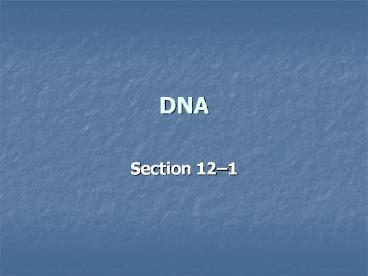DNA - PowerPoint PPT Presentation
Title:
DNA
Description:
DNA Section 12 1 This section tells about the experiments that helped scientists discover the relationship between genes and DNA. It also describes the chemical ... – PowerPoint PPT presentation
Number of Views:89
Avg rating:3.0/5.0
Title: DNA
1
DNA
- Section 121
2
- This section tells about the experiments that
helped scientists discover therelationship
between genes and DNA. It also describes the
chemical structure of the DNA molecule.
3
Griffith and Transformation
- What did Frederick Griffith want to learn about
bacteria? - He wanted to learn how certain types of bacteria
produce pneumonia
4
- The strain of bacteria that caused pneumonia grew
into_________ colonieson culture plates
harmless bacteria produced colonies with edges. - Smooth
5
- a. Mice injected with bacteria from smooth
colonies died. - d. Mice injected with a mixture of bacteria from
heat-killed smooth colonies and liverough
colonies died.
6
- What result from Griffiths experiment suggested
that the cause of pneumonia was not a chemical
poison released by the disease-causing bacteria? - The mice survived after being injected with
heat-killed disease-causing bacteria.
7
- What is transformation?
- It is the process by which one strain of bacteria
changes into another.
8
- What hypothesis did Griffith form from the
results of his experiments? - Some factor,which might be a gene, was
transferred from the heat-killed bacteria cells
into the live cells.
9
Avery and DNA
- Is the following sentence true or false?
- Avery and his colleagues thought that
themolecule required in transformation might
also be the molecule of the gene. - True
10
Avery and DNA
- Briefly describe how Avery and his group
determined which molecule was most important for
transformation? - They treated the extract of heat-killed bacteria
with enzymes that destroyed proteins, lipids,
carbohydrates, and other molecules, including RNA
and DNA.
11
Avery and DNA
- Briefly describe how Avery and his group
determined which molecule was most important for
transformation? - They treated the extract of heat-killed bacteria
with enzymes that destroyed proteins, lipids,
carbohydrates, and other molecules, including RNA
and DNA.
12
Avery and DNA
- Briefly describe how Avery and his group
determined which molecule was most important for
transformation? - They treated the extract of heat-killed bacteria
with enzymes that destroyed proteins, lipids,
carbohydrates, and other molecules, including RNA
and DNA.
13
Avery and DNA
- Transformation did not occur when _______was
destroyed. - DNA
14
Avery and DNA
- What was the conclusion from Averys experiments?
- DNA was the transforming factor.
15
The Hershey-Chase Experiment
- What is a bacteriophage?
- It is a virus that infects bacteria
16
The Hershey-Chase Experiment
- Parts that makes up a bacteriophage are
- Protein Coat
- DNA core
17
The Hershey-Chase Experiment
- What happens when a bacteriophage infects a
bacterial cell? - The bacteriophage injects its DNA into the cell.
The viral genes act to produce many new
bacteriophages, which burst out when the cell
splits open.
18
The Hershey-Chase Experiment
- How would Hershey and Chase learn whether genes
were made of protein or DNA? - If they could determine which part of the virus
entered the infected cell, they would learn
whether genes were made of protein or DNA.
19
The Hershey-Chase Experiment
- The molecule for which phosphorus-32 (32P) is
used as a radioactive marker is___. - DNA
20
The Hershey-Chase Experiment
- Is the following sentence true or false?
- 35S was found in the bacteria, it would mean that
the viruses DNA had been injected into the
bacteria___________. - false
21
The Hershey-Chase Experiment
- What results did Hershey and Chase observe?
- Nearly all of the radioactivity in the bacteria
was from phosphorus, the marker found in DNA.
22
The Hershey-Chase Experiment
- Hershey and Chase concluded that the genetic
material of the bacteriophage was_____. - DNA
23
The Components and Structure of DNA
- List the three critical things that genes were
known to do. - a. Genes had to carry information from one
generation to the next. - b. Genes had to determine the heritable
characteristics of organisms. - c. Genes had to be easily copied.
24
The Components and Structure of DNA
- Adenine, guanine, cytosine, and thymine are four
kinds of _______bases in DNA. - nitrogenous































